Van Gogh Museum Journal 2001
(2001)– [tijdschrift] Van Gogh Museum Journal–
[pagina 16]
| |
[Van Gogh and Gauguin]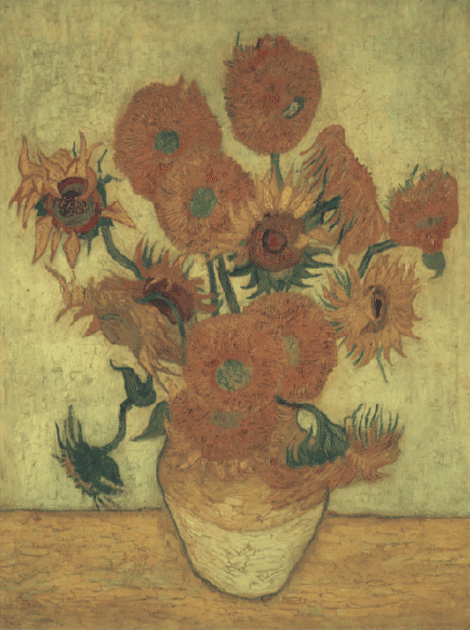 Vincent van Gogh, Sunflowers (F 457 JH 1666), 1888, Tokyo, Seiji Togo Memorial Yasuda Kasai Museum of Art (on permanent loan from the Yasuda Fire & Marine Insurance Company, Ltd)
| |
[pagina 17]
| |
The Tokyo Sunflowers: a genuine repetition by Van Gogh or a Schuffenecker forgery?
| |
[pagina 18]
| |
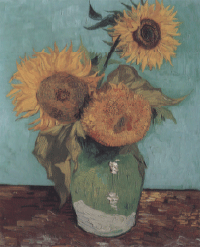 fig. 1
Vincent van Gogh, Sunflowers (F 453 JH 1559), 1888, Private collection 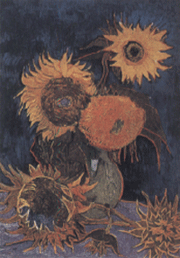 fig. 2
Vincent van Gogh, Sunflowers (F 459 JH 1560), 1888 (destroyed in 1945)  fig. 3
Vincent van Gogh, Sunflowers (F 456 JH 1561), 1888, Munich, Neue Pinakothek 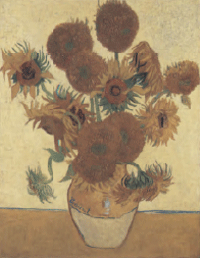 fig. 4
Vincent van Gogh, Sunflowers (F 454 JH 1562), 1888, London, National Gallery | |
[pagina 19]
| |
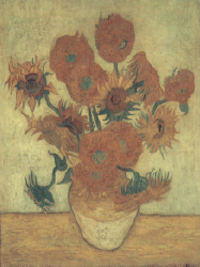 fig. 5
Vincent van Gogh, Sunflowers (F 457 JH 1666), 1888, Tokyo, Seiji Togo Memorial Yasuda Kasai Museum of Art (on permanent loan from the Yasuda Fire & Marine Insurance Company, Ltd) 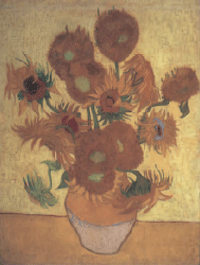 fig. 6
Vincent van Gogh, Sunflowers (F 458 JH 1667), 1889, Amsterdam, Van Gogh Museum (Vincent van Gogh Foundation) (photograph by René Gerritsen) 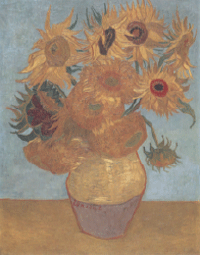 fig. 7
Vincent van Gogh, Sunflowers (F 455 JH 1668), 1889, Philadelphia Museum of Art, Mr and Mrs Carroll S. Tyson Collection 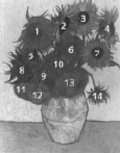 fig. 8
Numbering of the flowers as depicted in the Munich and Philadelphia versions (photograph of the Munich version) 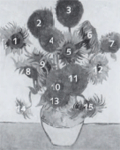 fig. 9
Numbering of the flowers as depicted in the London, Tokyo and Amsterdam versions (photograph of the London version) | |
[pagina 20]
| |
were produced in order to take the place of authentic works).Ga naar voetnoot5 On 26 October 1997 the parties challenging the authenticity of the Tokyo Still life with sunflowers received a boost from The fake Van Goghs, a documentary by the British journalist Geraldine Norman for Channel 4 in England. In the programme the work was described as ‘inferior’ and its provenance as ‘unclear.’ Tarica, like Landais, now pointed to errors of interpretation that he claimed were evident when the work was compared with its original, and to what he regarded as the clumsy brushwork that he alleged was inconsistent with Van Gogh's masterly hand. This view was also supported by Thomas Hoving, former director of The Metropolitan Museum and author of False impressions: the hunt for big time art fakes (1996), who at the end of the programme laconically summed up the objections to the work: ‘It is a very funny, muddy picture, and Van Gogh was not muddy. [...] It does not have that snap.’ Although Bogomila Welsh-Ovcharov and Roland Dorn both came to the defence of the traditional attribution - in 1998 and 2000 respectively - their contributions failed to put an end to the debate.Ga naar voetnoot6 Welsh-Ovcharov's arguments, which mainly concerned the work's provenance, were immediately contested by Landais.Ga naar voetnoot7 Dorn produced a more comprehensive rejoinder, which considered all the versions of the sunflowers, but like Welsh-Ovcharov he did not deal with the opposition's main arguments concerning perceived errors of interpretation and the anomalous brushwork. Thus opponents and supporters of the work partly talked at cross-purposes, and outsiders came to have the impression that the question of the Tokyo still life's authenticity was a matter of faith rather than of evidence. This article presents the authors' own research into the Tokyo painting's provenance, style and technique, at the same time considering the arguments of opponents and supporters alike. To date, the owner has been unwilling to subject the picture to a full physical and scientific test. However, permission was granted for an extensive visual examination in situ, while an x-ray of the work was also made available for study. Moreover, direct comparison with other versions of the Sunflowers was made possible when the painting was lent to the exhibition Van Gogh and Gauguin: the studio of the south in Chicago, where we were able to examine the Amsterdam and Tokyo works side by side.Ga naar voetnoot8 Prior to this exhibition Van Gogh's Arles ‘Sunflower’ paintings were subjected to individual technical examination in a joint campaign of undertaken by The Art Institute of Chicago and the Van Gogh Museum, carried out by Kristin Hoermann Lister, Inge Fiedler and Cornelia Peres. Some of their findings concerning the Tokyo version were published in the catalogue accompanying the exhibition, and our own research builds upon their pioneering work. We also drew great profit from our consultation of their examination reports of the different versions.Ga naar voetnoot9 | |
Correspondence and identificationScepticism about the authenticity of the Yasuda painting was fed, if not created, by the fact that although a | |
[pagina 21]
| |
total of five ‘Sunflower’ paintings on size 30 (92 × 73 cm) canvas are known (figs. 3-7), the artist only mentions four in his correspondence. The first size 30 version of this subject is reported in a letter from the final week of August 1888, when Van Gogh conceived the plan for decorating his studio with still lifes of sunflowers.Ga naar voetnoot10 Alongside two smaller still lifes with a small bouquet of flowers, he had commenced work on a painting with ‘douze fleurs & boutons dans un vase jaune (toile 30)’ [670/526]. This painting was ‘clair sur clair’ [670/526] and ‘sur fond bleu vert’ [674/W18]. Shortly afterwards he produced ‘un nouveau bouquet de 14 fleurs,’ as well as a ‘toile de 30’ [673/528]. According to Van Gogh's description, this still life also included a yellow vase, although the background was not blue-green but yellow, a colour he elsewhere described (just once) as ‘jaune vert’ [673/528].Ga naar voetnoot11 Some three weeks later the artist indirectly indicated that these two larger works had been completed [680/534].Ga naar voetnoot12 He had hung them in the spare bedroom - not in the studio - where Gauguin would have seen them in late October.Ga naar voetnoot13 After Gauguin had broken off his collaboration with Van Gogh, he informed his former companion in a letter sent from Paris in mid January that he would like to receive ‘un tableau de tournesols’ [740/571], apparently ‘les tournesols à fond jaune’ [743/-].Ga naar voetnoot14 Vincent seems to have been unsure whether Gauguin was proposing an exchange or a gift, and he did not really want to part with his paintings of this subject, as he told Theo.Ga naar voetnoot15 However, he did feel honoured by Gauguin's request. The latter had recognised the significance of the sunflower paintings for his oeuvre, he wrote in his reply, and he was thus willing to accede to his friend's wish, even to reward him: ‘comme j'approuve votre intelligence dans le choix de cette toile je ferai un effort pour en peindre deux exactement pareils’ [743/-].Ga naar voetnoot16 By this he meant not two new versions of the coveted still life with a yellow background, but rather repetitions of both that work and the still life with a blue background. In late January he informed Theo that he was in the process ‘de mettre les dernières touches aux répétitions absolument équivalentes & pareilles’ [747/574]. These repetitions appear to have been just completed when Joseph Roulin visited him at the end of January [748/575].Ga naar voetnoot17 As Van Gogh had now conceived the idea of displaying his still lifes of sunflowers in a triptych together with La berceuse (see p. 74) his friend saw ‘deux exemplaires de la Berceuse entre ces quatre bouquets-là’ [748/575]. A later sketch in a letter shows that the triptych comprised a portrait of Madame Roulin flanked by a still life with yellow background to her right and its blue pendant to her left (see p. 59).Ga naar voetnoot18 It has traditionally been thought that the still lifes painted in late August 1888 are the works now in London and Munich, a hypothesis supported by a comparative study of style and technique in the five works.Ga naar voetnoot19 Compared with the other three paintings, these two display looser, descriptive brushwork, a more elaborate modelling of form, and a more specific rendering of detail. The repetitions now in Tokyo, Amsterdam and Philadelphia, however, exhibit a logical trend towards increasing schematisation of the motif.Ga naar voetnoot20 | |
[pagina 22]
| |
Oddly, however, Van Gogh's descriptions of the bouquets in his letters do not match the actual number of flowers in the London and Munich paintings. According to his correspondence, the still life with a blue background contained 12 sunflowers; the Munich work, though, has 14 (figs. 3 and 8).Ga naar voetnoot21 The still life in London features 15 flowers, although Van Gogh speaks of only 14 in connection with this work (figs. 4 and 9).Ga naar voetnoot22 To err is human, of course, and in the case of the Munich picture it seems indeed that Van Gogh simply miscounted. The lower areas of the bouquet are rather tightly arranged, and sunflowers 5 and 9 are eclipsed by their more prominent neighbours (even taking into account that this effect may have been exaggerated by subsequent discolouration and loss of nuance).Ga naar voetnoot23 The London bouquet, however, is less compact, and it seems unlikely Van Gogh could have miscounted the flowers in this work.Ga naar voetnoot24 One possible explanation for the discrepancy is that flower 14, which was painted over the second and final layer of the background, had not yet been added when he described the still life in his letter.Ga naar voetnoot25 Van Gogh's correspondence does not provide us with an immediate answer to the question as to which of the three remaining still lifes should now be identified with the two repetitions painted in January 1889. Although Van Gogh described his two versions as ‘répétitions absolument équivalentes & pareilles’ [747/574], all three repetitions display clear differences of both detail and colour in relation to their originals, so that this passage is of little help.Ga naar voetnoot26 Apparently his choice of phrase referred only to the subject, which did indeed remain the same. However, shortly after completing the two repetitions, Van Gogh incorporated these new versions of the sunflower motif into the above-mentioned triptych with La berceuse. For this reason it may be conjectured that the works created in January are the paintings now in Amsterdam and Philadelphia (figs. 6 and 7), since, unlike the Tokyo canvas, they are signed, as is the central work from the triptych - with which, moreover, they form a stylistic unity.Ga naar voetnoot27 Like La berceuse - but not the Tokyo still life - both paintings incorporate a flat, decorative structure as well as a more full-bodied application of paint, although the latter predominates in the Sunflowers.Ga naar voetnoot28 From this it may be concluded that the work in Tokyo is not mentioned in the artist's correspondence. Although this absence could be interpreted as ‘un certificat de nonréalisation,’ as Landais has claimed, there are other, equally plausible explanations.Ga naar voetnoot29 For example, Van Gogh may have produced the painting with the intention of giving it to someone in Arles, thus seeing no reason to mention it to Theo. He may also have regarded it as a less successful version of the | |
[pagina 23]
| |
motif, or as an experimental study that similarly required no description. A further possibility is that he produced the work during a period of ‘little correspondence,’ as suggested by Dorn, and by Druick and Kort Zegers.Ga naar voetnoot30 Finally, one could also imagine that he simply failed to mention the work, for whatever reasons. While everything is possible one thing is certain: the letters do not provide any clues as to which of these options is the most plausible. | |
ProvenanceAlthough the correspondence cannot therefore help us to solve the problem of the painting's authenticity, the provenance may provide an indication. If it could be proven that the work came from Theo's estate, the case for considering the painting a forgery would, of course, be nullified. What is required is an examination of the provenance of all five pieces. The works in Munich, London and Amsterdam are irrefutably from the family collection. Johanna van Gogh-Bonger sold the first to Hugo von Tschudi in 1905; the second to the Tate Gallery in London in 1924.Ga naar voetnoot31 Following this second sale, only the Amsterdam canvas remained in the family's possession. It is not known if the painting in Philadelphia was among the works Jo administered. It is first documented in 1896, when the Paris art dealer Ambroise Vollard sold it as ‘soleils d[an]s pot’ to Comte Antoine de la Rochefoucauld on 21 December for 400 francs.Ga naar voetnoot32 Opinions differ regarding the provenance of the Tokyo version. However, opponents and supporters of the work's authenticity all agree that in the spring of 1901 it was included in the Van Gogh exhibition at the gallery of the Paris art dealers Bernheim Jeune, under the title Tournesols sur fond vert très pale.Ga naar voetnoot33 The painting came from the collection of artist Claude-Emile Schuffenecker, whom the exhibition's organiser - art critic, man of letters and Schuffenecker's friend, Julien Leclercq - had already described as its owner in a letter dated 16 February 1901.Ga naar voetnoot34 For many years the history of the work before 1901 was a mystery. In 1988, however, Walter Feilchenfeldt pointed to a family document from which it could be inferred that Schuffenecker had acquired his still life from Jo van Gogh-Bonger in 1894.Ga naar voetnoot35 In March of that year she accepted his offer of 300 francs ‘pour les fleurs’ - a work she had left at the shop of the recently deceased Père Tanguy.Ga naar voetnoot36 We know that this was in fact a painting of sunflowers thanks to a letter from Tanguy's widow to Andries Bonger, in which she reports that ‘Monsieur Chouffenecker [...] desirerai avoir un tableaux de Mr Vincent c'est le soleil.’Ga naar voetnoot37 | |
[pagina 24]
| |
This interpretation of the evidence, however, built as it is upon the knowledge that Schuffenecker owned the still life in 1901, has also become a subject of debate as a result of the controversy surrounding the authenticity of the Tokyo still life. Landais and others have claimed that the still life purchased by Schuffenecker in 1894 was not the painting now in Tokyo, but the Philadelphia canvas, which they contend the artist sold on to Vollard within two and a half years.Ga naar voetnoot38 Naturally, this theory is intimately connected to their refusal to believe in the Japanese painting's authenticity, for if the Tokyo work is a fake, the piece sold in 1894 must have been another version of the sunflowers. And this could only be the Philadelphia painting, as there is no other version whose earliest history is still unknown. However, if we consider only the evidence of the provenance, the latter theory appears far more speculative than the former. For while it cannot be demonstrated that Schuffenecker actually owned the Philadelphia still life, we can be certain that this was the case with the Tokyo version. Landais's notion could only gain in plausibility if other paintings could be discovered that the artist sold on soon after acquiring them. To date, however, no such examples have been found.Ga naar voetnoot39 | |
Four or five versions?In addition to the matter of this individual work's provenance, we should also consider numbers. How many versions are assignable shortly after Vincent's death? Did a fifth version already exist? Critics of the Tokyo painting believe not, basing their stance on the catalogue of works in Theo's collection (‘Catalogue des oeuvres de Vincent van Gogh’), probably compiled at the end of 1890 by his brother-in-law, Andries Bonger.Ga naar voetnoot40 This lists only four large format sunflower still lifes from Arles, each described as ‘Tournesol (30)’ and given the numbers 94, 119, 194 and 195. Ninety-four is definitely the painting now in Munich, while 194 probably refers to the Amsterdam version, as explained below.Ga naar voetnoot41 The other two numbers in the Bonger list do not immediately reveal their identity, meaning that this document cannot be used to prove the proposition that the Tokyo version was not yet documented in this period. Unless one agrees with the opinion that a fifth version did not exist at the time the presence of four rather than five versions of the sunflower motif in the Van Gogh family collection at this time can be explained if one painting had already left, either through exchange or as a gift. Here, the work in Philadelphia is the only possible candidate, owing to its unknown provenance. The recipient may have been Gauguin, for Vincent had promised him repetitions of the sunflower pictures. However, nothing in Van Gogh's correspondence suggests that he actually fulfilled this offer. The artist always thought in terms of an exchange, not a gift [744/573].Ga naar voetnoot42 Gauguin would have to reciprocate with ‘deux tableaux de lui pas mediocres mais mieux que médiocres,’ as he informed Theo in early February 1889 [749/576]. Vincent developed his proposal by almost | |
[pagina 25]
| |
immediately also offering Gauguin a version of La berceuse, indicating that he would rather have been represented in his friend's collection with the recently created triptych than the two repetitions of the sunflower still lifes from the spare bedroom.Ga naar voetnoot43 Although Gauguin's response to this proposed three-work exchange is not known, the fact that Van Gogh was still considering it in May indicates that nothing had yet been settled. Vincent then informed Theo that he should give Gauguin a version of La berceuse, but, he wrote, if his former companion ‘veut des tournesols ce n'est qu'absolument comme de juste qu'il te donne en échange quelque chôse que tu aimes autant’ [778/592].Ga naar voetnoot44 In other words, Van Gogh was ready to compromise by giving Gauguin the central work from his triptych, although he apparently expected the side panels to follow later through an exchange, since he knew his friend was keen on the sunflower still life with a yellow background. Van Gogh, however, seems to have misjudged the situation. Having been informed by Theo of the gift, Gauguin mentions only La berceuse in his reply from Pont-Aven: ‘Gardez le tableau à mon disposition’ [GAC 14]. It was not until 1894, long after the Van Gogh brothers had died, that he claimed the promised work from Theo's widow, without making any mention of the still lifes with sunflowers.Ga naar voetnoot45 Although the correspondence in no way intimates that Gauguin received one of the still lifes, the artist himself suggested in January 1894 that he had one of the versions with a yellow background in his studio. In a highly literary piece on Van Gogh, he wrote that his ‘chambre jaune’ contained ‘des fleurs de soleil, aux yeux pourpres, [...] sur un fond jaune, [...] dans un pot jaune, sur une table jaune. Dans un coin du tableau, la signature du peintre: Vincent.’Ga naar voetnoot46 This passage makes it clear, however, that Gauguin was not describing his studio as it actually was, but rather a form of fiction. The painting in Tokyo is not signed, while the other two works with a yellow background - the signed versions in Amsterdam and London - were still in the possession of Jo.Ga naar voetnoot47 Nevertheless, in 1998, Welsh-Ovcharov reckoned that Gauguin did indeed own a sunflower still life - not a yellow version but the work with the blue-greenish background in Philadelphia.Ga naar voetnoot48 In her opinion, this was the canvas referred to in an entry in the cash book kept by the Paris art dealer Ambroise Vollard, dated 10 April 1896: ‘Payé à [Georges] Chaudet de la part de Gauguin pour un tableau de Van Gogh “tournesols” 225 fr.’Ga naar voetnoot49 She seems, however, to have been mistaken, as Landais has also explained.Ga naar voetnoot50 In early 1895 Gauguin had commissioned Vollard to sell his two still lifes with sunflowers from Van Gogh's Paris period.Ga naar voetnoot51 One of these was sold that same year, while Vollard's 1896 reference appears to relate to the second, rather than to a new, more recently offered, work. The sum paid, 225 francs, seems too low to have been the price for one canvas, but as Gauguin had already received an advance of 400 francs for the two 1887 paintings from the dealer in 1895, it must have been a residual payment.Ga naar voetnoot52 Moreover, Gauguin wanted at least 600 francs | |
[pagina 26]
| |
for the two works, and the sum eventually paid, 625, comes very close.Ga naar voetnoot53 But if Van Gogh did not give Gauguin the painting now in Philadelphia, to whom did he give it? To no one probably, as it is unlikely that anyone other than his friend would have been the recipient of such a generous gesture. Exchanging or giving away this work would have meant that Vincent had abandoned his plan for securing a place for one of his triptychs in Gauguin's collection; this, however, seems improbable, given his great interest in the exchange.Ga naar voetnoot54 The only possible candidate is Emile Bernard, who, like Gauguin, also received a version of La berceuse. As far as can be determined, however, this artist never had a sunflower painting in his collection.Ga naar voetnoot55 This reasoning supports the conjecture that the work now in Philadelphia was still in the family collection at the end of 1890. However, if this was the case, the question of why Andries Bonger only recorded four versions of the sunflower motif instead of five becomes even more compelling. Roland Dorn suggests the answer should be sought in the function of Andries's list, which he believes was not a true inventory but rather a catalogue of the temporary presentation of Vincent's works in Theo's new apartment in September 1890.Ga naar voetnoot56 One still life with sunflowers was omitted from the list, and Dorn was convinced that this could only be the London painting, which may have been displayed in the window of Père Tanguy's shop to advertise the nearby exhibition. Although this is an ingenious theory, there is no supporting evidence. What is certain, however, is that the Bonger list contains several lacunae, as it is known that from 1892 onwards Jo van Gogh-Bonger began to use supplementary numbering for her own administration.Ga naar voetnoot57 However, this second ‘catalogue’, which has not been preserved, must have been similarly incomplete, as several documents from later periods contain descriptions of works without reference to either list.Ga naar voetnoot58 Surprisingly, one of these documents provides support for the proposed existence of a fifth, unnumbered version of the still life with sunflowers. In a list of 19 works sent to Leclercq on 8 October 1901, all the paintings have a Bonger list number except the ‘sunflowers’ noted under number seven.Ga naar voetnoot59 When the paintings were actually dispatched Jo rechecked the numbering and made several corrections; however, the listing for the sunflower picture was left unchanged, from which one can only conclude that the work did not actually have a number, as otherwise Jo would surely have added it.Ga naar voetnoot60 | |
[pagina 27]
| |
The painting in question was a still life with a yellow background, of which there were still two versions in the family collection: the canvases now in Amsterdam and London.Ga naar voetnoot61 Since the Amsterdam version can be associated with Bonger 194 (as will be shown below), the unnumbered painting sent to Leclercq must have been the London picture, proving Dorn's thesis correct (although his supporting arguments are different).Ga naar voetnoot62 In this interpretation, the four still lifes in Bonger's inventory can be identified as follows: 94, as already stated, is the painting now in Munich; 119 is the version in Philadelphia or Tokyo; 194 is probably the still life now in Amsterdam; and 195 either the painting in Tokyo or the Philadelphia version. | |
LeclercqAlthough the provenance offers no reason to doubt that the Tokyo Sunflowers is genuine, sceptics have produced still further arguments to challenge its authenticity. The crucial factor in their misgivings has been the knowledge that the work's owner in 1901, Claude-Emile Schuffenecker, had an opportunity to produce a forgery from another version of the motif. In June 1900 Jo van Gogh-Bonger sent eight works to Paris for a presentation at Leclercq's home. One of these was a version of the sunflowers,Ga naar voetnoot63 which arrived in a less than perfect condition and required restoration - as indicated by Leclercq's correspondence. Initially he spoke of lining the canvas, but in early February (when the restorer had apparently just seen the painting for the first time) Leclercq informed Jo that this would be impossible.Ga naar voetnoot64 Consolidating the paint subsequently proved to be sufficient and the treatment was completed in late March 1901, allowing the work to be exhibited for two days at the abovementioned exhibition at Bernheim Jeune.Ga naar voetnoot65 The painting sent to Paris was number 194 on the Bonger list.Ga naar voetnoot66 De Robertis and Landais both thought that this was the London version, but in light of the restorer's judgment that lining would be impossible, it seems more likely it would have been the work now in Amsterdam.Ga naar voetnoot67 This painting has a wooden lat at the top, added by the artist, which might not have made lining completely impossible, but certainly more complicated.Ga naar voetnoot68 Despite the still life's fragile condition, Leclercq was eager to purchase it.Ga naar voetnoot69 He could not afford the asking price, however, and once the exhibition was over he proposed an exchange, by which he would receive the still life in return for Van Gogh's Daubigny's garden, which he had recently acquired (fig. 10), plus an additional payment. | |
[pagina 28]
| |
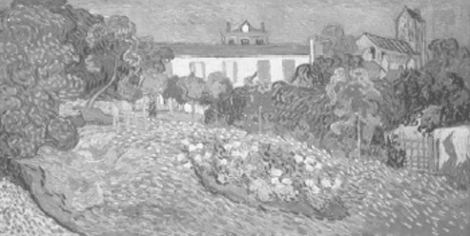 fig. 10
Vincent van Gogh, Daubigny's garden (F 776 JH 2104), 1890, Hiroshima Museum of Art Shortly afterwards, he even sent the canvas to Jo in order for her to judge the fairness of his suggestion.Ga naar voetnoot70 Jo, however, was unable to agree to this unusual offer, and the still life was probably returned to her in early May.Ga naar voetnoot71 De Robertis and Landais gave the following interpretation to these facts. Given Leclercq's ardour to possess the sunflower painting and his sometimes less than transparent commercial activities, they believe the information sent to Jo was intended to deceive her. According to their theory, there was no independent restorer: Leclercq's friend Emile Schuffenecker treated the damaged work and protracted the restoration in order to gain time to produce a free copy - the work now in Tokyo. The painter then presented his forgery at the Bernheim Jeune exhibition as an authentic Van Gogh, with the full knowledge of Leclercq.Ga naar voetnoot72 Seen in this light Leclercq's correspondence is part of an intrigue. However, the only important factors for us are the two premises that underlie this conspiracy theory: that Schuffenecker was a forger, and that he and Leclercq were untrustworthy schemers. | |
[pagina 29]
| |
SchuffeneckerThe notion that Emile Schuffenecker was a forger was first expressed during the late 1920s, when every avenue was being explored in the hunt for the maker of a group of forgeries that had recently been unmasked - the so-called ‘Wacker forgeries.’ Schuffenecker, along with his brother Amedée, was generally viewed as a possible suspect - although everyone admitted that they did not know the precise ins and outs of the situation. ‘It is [...] generally known that Schuffenecker painted pictures like Van Gogh, or copied them, or - if you wish - forged them,’ was a typical allegation made at the time.Ga naar voetnoot73 The origin of these rumours was - and is - unclear, although Julius Meier-Graefe probably played a significant role in their creation. At any rate this influential German critic would declare during the court case concerning the Wacker affair that ‘the painter Schoeffenecker [sic] has copied many paintings by Van Gogh’ and that he was ‘also aware’ that these had sometimes been sold as real Van Goghs.Ga naar voetnoot74 Landais and De Robertis combined these old stories with information from an unpublished manuscript by Judith Gérard-Moline, stepdaughter of music lover William Moline, whose circle of friends in the late 1880s had included Gauguin.Ga naar voetnoot75 This manuscript dates from circa 1950 and was inspired by her anger towards Leclercq and Schuffenecker, whom she represents as untrustworthy. Apparently referring to Jo's consignment of 1900, she wrote that Leclercq had managed to get Van Gogh's works to Paris, but that he had handled them with little respect. The paintings had allegedly been damaged during the journey and for this reason he had called on Schuffenecker for assistance, who was then working at the Lycée Michelet in Vanves as a drawing teacher. Subsequently, according to Gérard-Moline, the artist treated Van Gogh's paintings as if they were studies by his students, and with Leclercq's permission he made a number of corrections, adding grey clouds to Houses at Auvers (F 802 JH 2001) and painting out the cat in Daubigny's garden (fig. 10).Ga naar voetnoot76 Where, however, lies the truth in this amalgam of accusations? Although a definitive biography of Schuffenecker has yet to be written, the facts as they are presently known suggest the following scenario.Ga naar voetnoot77 While it seems reasonably certain that his brother Amedée (who took over the major portion of Emile's collection in 1903 and subsequently made a lasting career in the art trade) at some point became involved in dubious practices, it is difficult to ascertain whether Emile can be accused of the same.Ga naar voetnoot78 Although in 1909 the artist issued a certificate of authenticity for a work which was unjustifiably considered to be a Van Gogh (fig. 11), this does not necessarily point to deliberate foul play. During this period Van Gogh's oeuvre had not been catalogued in any definitive way, and erroneous attributions were the order of the day. Nor is it possible to confirm or deny that Schuffenecker produced ‘many copies’ after Van Gogh, as Meier-Graefe contended.Ga naar voetnoot79 Only one such copy is known, a repetition in pastel of Vincent's Self-portrait with bandaged ear (F 529 JH 1658), which he must have bought early on.Ga naar voetnoot80 The ‘small, fragmentary repetition’ after Van Gogh's Prisoners at exercise: copy after Gustave Doré, once in Amedée's collection, however, is highly suspect. The piece has since vanished and it is therefore impossible to tell whether Emile painted it or not.Ga naar voetnoot81 In conclusion, | |
[pagina 30]
| |
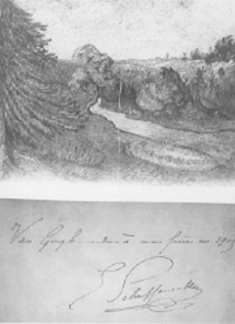 fig. 11
Claude-Emile Schuffenecker's expertise on a work (mistakenly) presumed to be by Van Gogh, Private collection (copy in the archives of the Van Gogh Museum, Amsterdam) although Meier-Graefe may have been telling the truth, the facts are too few to corroborate his statement.Ga naar voetnoot82 Thus, while Schuffenecker may have produced copies after Van Gogh, there is no evidence that he actually forged works. To date there are no known Schuffenecker forgeries - unless one presumes a negative outcome to the current research into the authenticity of certain works traditionally attributed to Van Gogh, but which some believe to have been painted by Schuffenecker, like the Tokyo Sunflowers. Furthermore, there is a lack of documentary evidence, nor did the artist's contemporaries characterise him as fraudulent. He was occasionally described as a speculator, but this is certainly not the same as accusing him of being a forger.Ga naar voetnoot83 Gérard-Moline's recollections are typical in this respect: she wrote down many unpleasant things about the painter, but never exposed him as a forger. Her indignation was aroused purely by his tendency to correct details in Van Gogh's works as he saw fit. Of all the accusations levelled at Schuffenecker, this is the only one that is well founded. Although Van Gogh's Houses in Auvers, which belonged to Leclercq, was never filled with grey clouds as Gérard-Moline alleged, Daubigny's garden (fig. 10), which Schuffenecker acquired from the former in 1901, does indeed feature a painted-over cat.Ga naar voetnoot84 Since the correcting of ‘intrusive’ elements in paintings had a long and respectable tradition, Gérard-Moline's anger seems somewhat exaggerated. However, it must be said that Schuffenecker's corrections went further than was customary, for he not only painted out the cat, he | |
[pagina 31]
| |
also retouched the edges and even added a wide strip at the top.Ga naar voetnoot85 Moreover, similar additions to the picture area are found in three other works from the collection of either Emile or Amedée: in the first version of Van Gogh's Daubigny's garden (F 777 JH 2105), his Portrait of Camille Roulin, and in Gauguin's Human miseries (figs. 12 and 13).Ga naar voetnoot86 Altering the format of 19th-century paintings does not appear to have been common practice, but seems instead to have been a personal predilection of the painter-restorer's. The rarity of this phenomenon and the common provenance of the above-mentioned paintings, therefore, strongly suggest that these interventions were indeed the work of Schuffenecker.Ga naar voetnoot87 The artist must have been disturbed by Van Gogh's non-traditional cropping of the picture area, a style he himself never used in his own, more academic work. To date, there has been no comparative technical investigation of all these additions, although two paintings have been subjected to detailed examination. In the first of these, Van Gogh's Portrait of Camille Roulin (fig. 12), unfolded tacking margins were used to extend the right and left sides of the composition by 1.5 cm, and the lower edge by 2.5 cm.Ga naar voetnoot88 The 2 cm-wide extension down the left side of Gauguin's Human miseries, on the other hand, was created by attaching an extra strip of canvas (figs. 13, 14). Interestingly, the Tokyo Still life with sunflowers has been similarly enlarged, using a combination of the two methods. The work was extended by about 1.5 cm on four sides by flattening out the tacking margins, while a new strip of canvas was attached to create an additional 4 cm extension at the top (fig. 15). Moreover, an x-ray comparison has revealed that this strip looks very close or even identical to the extension to Gauguin's Human miseries (fig. 13). Both fabrics share a matching thread count, with an average of 6-6.5 warp and 5-5.5 weft threads per centimetre. In the case of the jute strip added to the Sunflowers, the weft count actually comprises paired thin threads in a basket-weave pattern (as opposed to the plain weave of the original jute canvas). Unfortunately, poor definition of the canvas weave in the x-ray of the addition to Human miseries makes it impossible to be certain whether this is the case here too.Ga naar voetnoot89 In the case of both paintings, the additions have been simply joined edge-to-edge with the main canvas. In Human miseries the added strip is held in place by the application of a glue lining. However, judging from the x-ray of the unlined Tokyo painting, in this case the strip was - and still is - held by a wooden lat, now nailed to the top of the stretcher. The idea for extending the top in this way may have been provided by the Amsterdam Sunflowers, which, as noted above, was probably the version displayed in the 1901 Bernheim Jeune exhibition. In the case of the Amsterdam work, Van Gogh enlarged the picture area by painting directly onto the wooden lat affixed to the top side of the stretcher.Ga naar voetnoot90 | |
Forgery?The above observations provide cumulative evidence that Schuffenecker was most likely responsible for the extensions to the Tokyo painting. In the light of this, it would be illogical to believe he forged the rest of the painting, at the same time taking the trouble to fabricate separate extensions and to paint them in an entirely different style.Ga naar voetnoot91 | |
[pagina 32]
| |
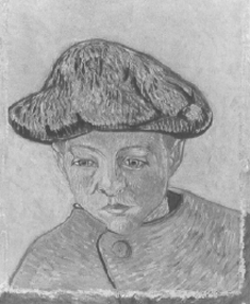 fig. 12
Overall view by normal light after treatment (October 1991) of Vincent van Gogh, Portrait of Camille Roulin (F 537 JH 1644), 1888, Philadelphia Museum of Art, Given by Mrs Rodolphe Meyer de Schauensee If this seems to militate against writing the work out of Van Gogh's oeuvre, the painting's critics have offered other, equally forceful arguments to support their position. They have, for example, drawn attention to two conspicuous details. The first of these concerns the leaf that belongs with the drooping flower to the left, number 14, through which the flower-stem passes. Leaves encompassing the stem in this way are not characteristic of sunflowers. In the first version - the work in London - the stem runs slightly into the leaf, which may have erroneously created the impression of a leaf encompassing a stem. The second concerns the broken stem of flower number 7 (fig. 5). When sunflowers snap, the top part falls forward due to the weight of the head, but surprisingly this is not the case here. The overblown bloom still stands proudly upright, as it does in the London painting, which served as its model; however, the stem in that work is not broken, only slightly bent. For these reasons critics of the Tokyo still life have concluded that it cannot be a repetition by Van Gogh's own hand. In their opinion, the artist could certainly not be reprimanded for lacking knowledge of sunflowers, and therefore the author of the work must have been a copyist.Ga naar voetnoot92 Although this conclusion at first seems reasonable, it is undermined when we examine the repetition in Philadelphia. Like the picture in Tokyo, this work also has an ‘incongruously’ snapped stem in the place where its prototype, the still life in Munich, only features a slightly bent example (cf. figs. 3, 7 and 8, flower number 4). This means that the ‘errors of interpretation’ in the Tokyo version need not necessarily be ascribed to a copyist; they could equally well be work of Van Gogh himself repeating his motif. If this is indeed the case, the leaf enclosing the stem can only be attributed to carelessness, or a lack of botanical knowledge or interest on the artist's part. The ‘incongruously’ snapped stem, on the other hand, appears to be a deliberate stylisation, as the same angular form also recurs in the portrait of Madame Roulin (see pp. 74-75), where some of the dahlias on the background wallpaper have similarly snapped stalks. This sacrifice of botanical reality to abstraction and stylisation is moreover apparent in all the repetitions. No botanist would recognise a sunflower in the sea-anemone-like structure of the dark head in, for example, the Philadelphia version (figs. 7, 8). The green hearts of the overblown flowers in the two repetitions of the London picture are equally unnatural. Unlike in the latter work, where the varied transition from open peripheries to the still closed flowers in the hearts of the sunflowers is clearly depicted, the repetitions instead employ separate, closed circles that create the mistaken impression that these are entire heads. Taking this into account, it becomes difficult to base acceptance or rejection of the Tokyo still life on so-called ‘errors of interpretation.’ The only recourse can be evidence concerning style and technique. In this context, critics of the Tokyo work have stated the following objections.Ga naar voetnoot93 Landais claims that the way the painting has been | |
[pagina 33]
| |
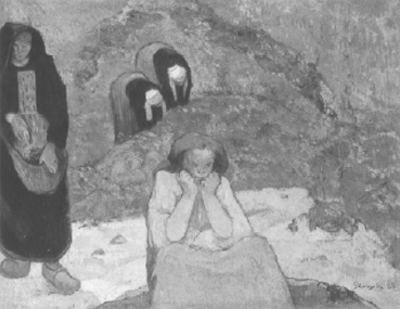 fig. 13
Paul Gauguin, Human miseries, 1888, Ordrupgaard, Ordrupgaard Sammlungen (photograph by Ole Woldbye) built up does not correspond with Van Gogh's method of working. According to him, the artist would have painted ‘first the colours and only later the contour line’; the petals on sunflower 1, however, display the opposite approach.Ga naar voetnoot94 Furthermore, Matthias Arnold considers it suspicious that the background has been filled in around the flowers, over-lapping their contours - again contrary to Van Gogh's usual procedure.Ga naar voetnoot95 He also regards the brushstroke as problematic, contending that it is ‘much more uneven and irregular than in the two versions definitively ascribed to [the artist].’Ga naar voetnoot96 Landais speaks of a ‘mechanical hand,’ while Hoving disparagingly used the word ‘muddy.’ Tarica also 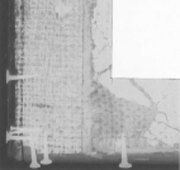 fig. 14
Detail of x-ray of fig. 13 | |
[pagina 34]
| |
pointed to the sometimes-frayed character of the brushstroke, which he regards as uncharacteristic of Van Gogh.Ga naar voetnoot97 None of these critics, however, appear to have studied the painting in a systematic fashion. For example, they have failed to take into account the picture's support. Joint research conducted by The Art Institute of Chicago and the Van Gogh Museum, involving a detailed comparative study of x-rays, has confirmed that the material on which the Tokyo Sunflowers is painted exactly matches the jute fabric used for other works by Van Gogh and Gauguin, and thought to have been cut from the 20-metre roll bought by the latter at the beginning of November 1888.Ga naar voetnoot98 The canvas is similarly of plain weave, and its thread count falls within the same range of 5-5.5 warp by 6.5 weft threads per centimetre (fig. 15).Ga naar voetnoot99 The thinner and less closely packed warp threads run horizontally, indicating that the canvas was orientated perpendicularly with respect to the axis of the roll. Along the top of the original canvas there is a narrow (1.5 cm wide) tacking edge, which, like the other three tacking edges, was later flattened and incorporated into the picture area. Although slightly frayed, the tacking edge seems virtually intact, preserving strong cusped deformations with accompanying tack holes where the canvas was originally fixed to the working frame. Again this is consistent with some of the other pictures examined originating from the same jute roll, which also feature narrow (1.5-2 cm wide) tacking margins along the selvedge and opposite sides.Ga naar voetnoot100 Although the jute fabric was most probably manufactured in France, methods and machinery shared between countries make this difficult to confirm.Ga naar voetnoot101 A characteristic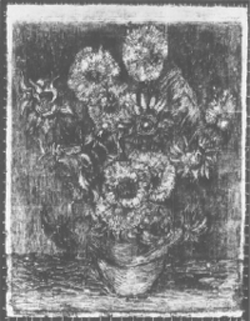 fig. 15
X-ray of Vincent van Gogh, Sunflowers (F 457 JH 1666), 1888, Tokyo, Seiji Togo Memorial Yasuda Kasai Museum of Art (on permanent loan from the Yasuda Fire & Marine Insurance Company, Ltd) | |
[pagina 35]
| |
selvedge comprising different coloured warp threads interwoven in various patterns may sometimes be associated with a particular maker or region. To date, however, it has not been possible to link the plain type of selvedge on the Gauguin/Van Gogh roll with a specific place of manufacture.Ga naar voetnoot102 Comparison with surviving historical samples of jute cloth suggests that the quality was equivalent to the type employed as hessian bagging for sugar sacks.Ga naar voetnoot103 Although it may be presumed that the jute purchased in Arles was a type that was readily available, examination of Gauguin's later paintings has not yet identified any canvas that could provide an exact match.Ga naar voetnoot104 The jute fabric used by the two artists at Arles is thus a distinctive material, with its own particular characteristics. The fact that the Tokyo picture is painted on precisely the same kind of cloth provides compelling if not conclusive evidence of its authenticity. Based on visual examination of the Tokyo still life, the exact nature of the ground applied is at present uncertain. In places a translucent pinkish layer is evident, which resembles the idiosyncratic barium sulphate ground that Van Gogh and Gauguin began to use at the beginning of November, having abandoned their initial choice of chalk-glue priming.Ga naar voetnoot105 Elsewhere, however, there seems to be a denser white layer, which could be a lead and/or zinc white-in-oil ground, such as subsequently employed by both artists. This is possibly a transitional technique, with the white oil ground applied on top of the barium sulphate one, but further research would be required to confirm this. Surface examination has identified an underdrawing on this ground that employs a dry black material resembling charcoal. These contour lines are exposed between adjacent paint areas where these do not quite meet. Examination of the other versions has revealed a similar preliminary outlining of the composition; in the case of the repetitions this may be the result of tracing, as demonstrated by Kristin Hoermann Lister elsewhere in this Journal. There is also evidence that in the Tokyo Sunflowers, as in the Amsterdam version, Van Gogh returned to the use of charcoal to redefine certain contours at a later stage of painting. Thus, drawn contour lines run over the initial painted lay-in of the flowers and background in places. Examples in the Tokyo still life are the outlines of the lower petals of flower 13 against the vase, as well as some outer petal edges in flower 8, and the outlined centre of flower 9. (figs. 1, 5) In the Amsterdam version, the edges of the yellow petal facing down to the right of the green bract in flower 13 were similarly redrawn with charcoal after the first painted lay-in of the composition (fig. 6).Ga naar voetnoot106 When viewed with the naked eye, the palette used in the Tokyo painting appears entirely consistent with other works by Van Gogh from the period, in particular the ‘Sunflower’ series. The yellow shades employed in the flowers themselves all appear to have darkened in a similar manner, owing to the use of specific lead chromate paints. In places, tiny areas of damage have exposed a brilliant yellow colour in the interior of the paint film where this has been shielded from the light. Similar spots of damage in the green passages reveal that these have also become | |
[pagina 36]
| |
 fig. 16
Vincent van Gogh, Vincent's chair (F 498 JH 1635), 1888, London, National Gallery darker at the surface, and perhaps consist of the same emerald green (copper acetoarsenite) pigment used in the other versions. As is the case with the other sunflower paintings, these observations provide some idea of the original bright colour scheme, incorporating detailed nuances that have now been lost.Ga naar voetnoot107 Although Arnold's contention that the background in the Tokyo still life was painted around the flowers has been proved correct, this is not a reason for excluding the work from Van Gogh's oeuvre, as the Philadelphia version displays the same sequence. The flowers have been built up in a variety of ways. In the case of the petals of flower 1, the orange contours were drawn before these were filled in with yellow paint, as Landais observed. However, elsewhere, for example in flower 12, the reverse order is evident. Moreover, both methods are used in flower 8 of the Philadelphia version. The involucral bracts (the small rosette of leaves supporting the head) were first outlined in brown, then filled in with green before the contours were finally accentuated with yellowish and dark green paint. Thus, despite Landais's claims, it is not possible to conclude that Van Gogh invariably employed one singular working method. Although critics of the Tokyo still life have argued that the brushwork is atypical, comparison of the individual elements in fact reveals close parallels with the artist's other works. For example, the impasto texturing of the overblown sunflowers strongly resembles that employed in the Amsterdam version. The latter also displays a similar patterning in the background, which in places is structured by crosshatched or ‘basket-weave’ strokes. While the long, parallel brushstrokes present in the foreground of the Tokyo still life may not occur in the other versions, comparable vertical strokes were used to depict the door in, for example, Vincent's chair (fig. 16). Viewed in its entirety, however, the texture of the paint surface is somewhat idiosyncratic. Although the other sunflower versions exhibit a contrast between thinly and thickly applied areas, the Tokyo picture has a substantial paint layer throughout. Furthermore, the pronounced impasto in the foreground and vase seems particularly obtrusive and was undoubtedly a major source of the critics' mistrust. However, these authors have not taken into account the unusual choice of material for the picture support, namely jute. This sheds a different light on the heavily laden paint applied throughout, as will be explained below. The frayed ends to trailing brushstrokes criticised by Tarica are also the result of this coarse fabric: in places the corrugated surface has caused individual strokes to lose their definition, a clear example being the ragged edges to the final green contours around the stalks and leaves. | |
[pagina 37]
| |
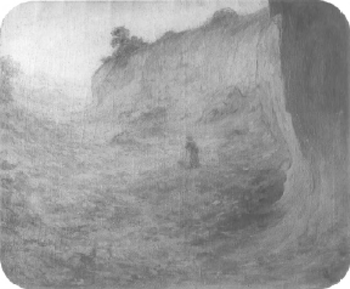 fig. 17
Raking light photograph of Claude-Emile Schuffenecker, Landscape with a draughtsman, 1888, Amsterdam, Van Gogh Museum Finally, while the particular paint application in the Tokyo still life closely resembles the brushstroke in Van Gogh's other paintings, it has little in common with that of Schuffenecker. His technique comprised a far from spontaneous, insubstantial application of paint, which involved the superposition of thin unbounded veils of colour. He largely avoided impasto, as a raking light photograph of his Landscape with a draughtsman clearly shows (fig. 17). From the mid-1890s Schuffenecker specialised in pastels and drawings, media that were well suited to his flatter approach. By the 20th century he had almost ceased to paint, making it highly implausible that in 1901 he would have been tempted to copy a work by Van Gogh, whose style was so alien to him. | |
FalsificationGiven that none of the aspects thus far examined - the provenance, the picture support, the sequence employed in building up the image, the colour palette, the brushwork - provide reason enough for eliminating the Tokyo Sunflowers from Van Gogh's oeuvre, the forgery theory should now be checked for consistency. The cornerstone of this theory is the critics' belief that the Tokyo version was based on the work sent to Leclercq in June 1900.Ga naar voetnoot108 They presume this to have been the London picture, but leaving the question of whether or not this is really correct, if the still life is indeed a forgery, it can only exhibit morphological resemblances to one of the two other versions, never to both. It is evident that the still life in Tokyo was inspired by the London canvas. For example, bud 6 features protruding tubular flowers that also appear in the first work, but not in the Amsterdam repetition. Moreover, the interpretive error apparent in the leaf of flower 14 can only be explained by the London still life, as is also the case with the almost dappled treatment of the petals of flower 15. In the Amsterdam version this element differs completely from its counterpart in London, as it is based on flat planes of colour. The critics were left with no alternative but to declare that Schuffenecker had copied the London rather than the Amsterdam version. However, they have focused their attention entirely on the form and treatment of the stalks and flowers, failing to consider the colours, which tell quite a different story. For example, the background of the London picture is an | |
[pagina 38]
| |
extremely pale yellow, over which a barely perceptible layer of greenish-yellow has been applied. The background in the two repetitions, however, consists of a virtually identical greenish-yellow, altough this is often hard to judge from colour reproductions. In the London still life the centres of the faded flowers have been rendered in an arbitrary mix of green and yellow ochre, but in both repetitions they are made up of large segregated planes of colour.Ga naar voetnoot109 Furthermore, when the schematisation and abstraction of the flower forms is considered, the repetitions in Tokyo and Amsterdam are found to bear a greater resemblance to each other than to their joint ancestor. For example, the stalks of sunflowers 2, 4 and 7 in the London version have a rounded form, while in the repetitions these elements are ‘flattened’ and bounded by contours. Also, as stated above, the modelled centres of the faded flowers in the London still life have been replaced by flat discs of colour in both repetitions. Thus, while the subject in the Tokyo version has certainly been copied from the London painting, in terms of its main colours and schematisation the still life displays more similarities to the Amsterdam work. This observation nullifies the forgery theory once and for all: Schuffenecker could only have taken one of the two versions as his model. It would have been plainly impossible for him - unless one believes in miracles - to introduce changes in form and colour that precisely match the details of a version he definitely would not have seen. | |
DatingThe similarities between the two repetitions of the London still life raise the question of whether the Tokyo version was painted before or after the one in Amsterdam. The Tokyo work has traditionally been regarded as the last in a series of three and dated to February 1889 (or later). Dorn has contended that it was painted at the beginning or end of February, periods when Van Gogh was prevented by his illness from keeping his brother informed about his recent output.Ga naar voetnoot110 Although his resumption of the use of jute is inconsistent with the rest of his artistic production at the time, this objection may be partially overcome if it is considered that his choice of material may indicate that he made the repetition especially for Gauguin, who favoured this type of support. Nevertheless, the 1889 date has proven incorrect. As indicated above, the painting was executed on jute from the 20-metre roll Van Gogh and Gauguin used in November-December 1888. As Lister, Peres and Fiedler have shown in their reconstruction of the artists' output - based on the individual alignment of all their works within the roll - the 20 metres must have been depleted by the end of December, when Gauguin left Arles.Ga naar voetnoot111 This suggests the Tokyo still life should instead be dated to some time in the last two months of 1888. Moreover, the composition of the priming layer might yet allow allows us to date the work with still more precision. If this layer does indeed prove to consist of both barium sulphate and lead and/or zinc white, it would be reasonable to assume that the still life was painted in late November, when the two artists replaced the first type of primer with the second. Should it turn out that only a white oil ground is present, this would still situate the painting to some time between this date and the end of December.Ga naar voetnoot112 Furthermore, the picture seems to have formed part of a specific artistic dialogue between Gauguin and Van Gogh, as suggested, for example, in a later account by the former concerning his activities in Arles. In 1902, when Gauguin felt André Fontainas had given too much credit to Van Gogh in a review, the artist sought to correct his claims by informing the critic that in fact the Dutch painter had learned much of what he knew from him, Gauguin: ‘Van Gogh, influencé par les recherches néo-impressionnistes procédait toujours par grandes oppositions de ton sur une complémentaire jaune, sur violet, etc. Tandis, que plus tard, d'après mes conseils et mon enseignement, il procéda tout autrement. Il fit des soleils jaunes sur fond jaune, etc., apprit l'orchestration d'un ton pur tous les dérivés de ce ton.’Ga naar voetnoot113 | |
[pagina 39]
| |
This anecdote has always been dismissed as Gauguin's attempt to discredit his former painting companion, as neither the still life in London nor the later repetitions were thought to have been painted during Gauguin's sojourn in Arles. However, if Van Gogh did indeed produce the Tokyo version in this period, it seems reasonable to assume that the reference to ‘soleils jaunes sur fond jaune’ was not an allusion to the painting now in London but rather to the Tokyo version.Ga naar voetnoot114 Although it is difficult to determine if Gauguin actually gave Van Gogh advice regarding the Tokyo still life, this would seem plausible. He was certainly occupied with ‘l'orchestration d'un ton pur tous les dérivés de ce ton’ during his time in Arles: it is known that in late November he began ‘une grande nature morte de potiron orangé et des pommes et du linge blanc sur fond et avant plan jaune’ [727/558a]. Given that Van Gogh in his subsequent letter reported a great liking for this, now lost ‘still life with yellow fore- and background’ [728/560], it is conceivable that he produced the Tokyo Sunflowers in response. This inferred artistic dialogue also finds a parallel in the portraits the two artists made of each other in late November/early December. In his Portrait of Paul Gauguin Van Gogh represented his companion at work in front of a predominantly yellow painting (fig. 18), which has been identified on the basis of the spherical form to the left on the canvas as the still life with pumpkins.Ga naar voetnoot115 Shortly afterwards Gauguin responded with his Portrait of Vincent van Gogh painting sunflowers (fig. 19), whose conception in turn may have been inspired by Vincent's painting of the Tokyo still life. The highly stylised flowers provide grounds to support this theory, as they could not have been painted from life and appear to be based on Van Gogh's schematised flowers in the Tokyo work: their green hearts are represented as circles in the same unrealistic fashion.Ga naar voetnoot116 On the grounds of all this evidence, it may be conjectured that the Tokyo still life was painted in the last week of November, or during the first days in December 1888, between Gauguin's pumpkin still life and his Portrait of Vincent van Gogh painting sunflowers. | |
The ‘Sunflowers’ seriesThe still life's new place in the ‘Sunflowers’ series not only reveals a great deal about Van Gogh's motivation and intention as regards this particular piece; it also sheds light on the development of the group as a whole. Although Dorn has contended that the differences between the versions were primarily inspired by the artist's need to systematically apply a specific colour theory, the painting's new position within the series gives rise to quite a different interpretation.Ga naar voetnoot117 Van Gogh's original plan, as indicated by his description in late August, had been to depict the sunflowers against a blue background. At that time he envisaged ‘un décoration où les chromes crus ou rompus éclateront sur des fonds divers, bleus depuis le véronèse le plus pâle jusqu'au bleu de roi, encadrés de minces lattes peintes en mine orange’ - the intention being to create ‘espèces d'effets de vitraux d'église gothique’ [669/B15]. In his first study of the motif Van Gogh cautiously explored the possibilities (fig. 1). In keeping with his initial idea, this little still life has a decorative structure based on planes of colour, and also features the use of complementary effects, mainly evident in the opposition between the purplish-brown table and the yellow in the sunflowers. In the second, somewhat larger study, however, in which Van Gogh exactly repeated the subject (with the addition of several flowers lying in the foreground), colour contrast began to play an even greater role (fig. 2). The artist replaced the bluish-green of the background with royal blue and made marked use of orange aureoles: ‘c.à.d. chaque objet est entourée d'un trait coloré de la complémentaire du fond sur lequel il se detache’ [672/527]. The strong contrast thus produced, in combination with the introduction of distinct contouring, successfully created the artist's intended stained-glass window effect. | |
[pagina 40]
| |
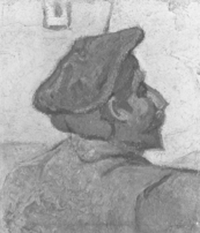 fig. 18
Vincent van Gogh, Portrait of Paul Gauguin (F 546 JH -), 1888, Amsterdam, Van Gogh Museum (Vincent van Gogh Foundation) However, Van Gogh soon became dissatisfied with this experimental work, and shortly after its completion he described the use of aureoles as ‘un dogme universel’ [673/528]. Although it was ‘un véritable découverte,’ he himself preferred the painterly approach of Edouard Manet, thinking in this context particularly of Manet's Still life with peonies of 1864 (Paris, Musée d'Orsay). ‘Simplicité de technique,’ that was what he was aiming for, ‘un travail de la brosse sans pointillé ou autre chose, rien que la touche variée’ [672/527]. A simple but varied brushstroke would henceforth play an important part in the further development of the series. Van Gogh also seemed disillusioned with the use of complementary contrasts, as demonstrated by his subsequent work, the still life now in Munich - his first treatment of the sunflower motif in size 30 (fig. 3). In accordance with his initial conception of the series, he now allowed the primary colours blue and yellow to predominate, although he did not opt for a strong tonal contrast between the two. His aim was now a ‘clair sur clair’ effect [670/526]. The Munich work must have been an ambitious ‘étude de nature,’ Van Gogh's next piece, however - the London still life - was an attempt to produce a ‘tableau définitive’ (fig. 4). While his brushstroke in the Munich painting was still fairly arbitrary, the artist now chose a more serene, stylised treatment, practising his philosophy of ‘la touché variée’ by creating even, flat areas of thinly applied paint in addition to the impasto passages. He also introduced a greater sense of space into the composition of the bouquet, distributing the overblown flowers and their still blooming companions over the whole with a greater feeling for variety. In order to perfect his ‘clair sur clair’ effect Van Gogh seems also to have made several changes to the colour scheme, toning down the light-dark contrast between background and subject still further. While the Munich still life featured five flowers with a reddish-brown heart (currently darkened by age), he here reduces the prominence of this element. He also painted the leaves and stalks in a light rather than dark green, and gave the background another colour, replacing the heavily whitened turquoise in the Munich still life with light yellow, a much better choice for light-on-light painting, due to its inherent light tonal value. The result was a light tone similar to the background of the London version. In changing the background colour Van Gogh departed from his original intention of painting the series as yellow on blue. The main colours thus became ‘the three chromate yellows, yellow ochre and veronese green and nothing else’ [745/571a]. He subsequently compared the work to his Paris Still life with lemons and quinces (F 383 JH 1339), which was also mainly yellow, but whose execution was less ‘bien plus simple’ [673/528]. This learning to use yellow and other closely related colours was apparently a project dear to Van Gogh's heart, for in the spring of 1888 he had also attempted to master the artistic problems it entailed, producing Still life with a bottle, lemons and oranges (F 384 JH 1425). The challenge of course lay in making the greatest possible use of yellow and its derivatives, without losing definition of form, which theoretically required contrast. In late November 1888 this exercise suddenly came to the forefront once again. As we know, Gauguin had ventured into the same field with his yellow still life with | |
[pagina 41]
| |
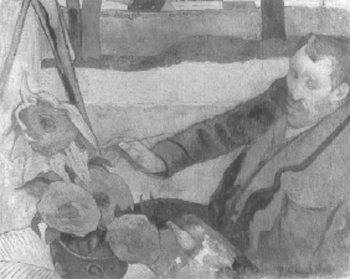 fig. 19
Paul Gauguin, Portrait of Vincent van Gogh painting sunflowers, 1888, Amsterdam, Van Gogh Museum (Vincent van Gogh Foundation) pumpkin and apples. Doubtlessly his companion wished to respond with a new painting in yellow, choosing his favourite motif: the sunflowers.Ga naar voetnoot118 The flowers, however, had finished blooming long before, preventing him from producing a new work from nature. Evidently this resulted in the decision to paint a free repetition after the still life now in London (fig. 5). Several features suggest that in the Tokyo version Van Gogh sought an even more radical way to achieve the light-on-light effect. Abandoning the London picture's light-yellow background, with its barely perceptible top layer of greenish-yellow, he chose instead a more saturated form of the same greenish-yellow, further eliminating the contrast with the bouquet. Probably for the same reason he also made the overblown flowers somewhat lighter than in the London work, where the orange and greenish-yellow colours seem to have been deliberately toned down by the application of thin layers of dull orange-brown paint on top.Ga naar voetnoot119 Although this reduced contrast to a minimum, Van Gogh apparently wished to retain it to some degree, as he used dark green for the stalks and the leaves, elements which in the London piece are more yellow-green in colour.Ga naar voetnoot120 In addition to these moves towards the objective of achieving a radical light-on-light effect, the jute support | |
[pagina 42]
| |
forced the artist to find new ways of obtaining a varied texture in the paint surface - his second challenge.Ga naar voetnoot121 While the brushstroke used for the flowers and background is virtually identical to that employed in the London painting, Van Gogh was unable to repeat the thinly painted areas in the pot and foreground without encountering problems. Unlike Gauguin, he was apparently less willing to exploit the texture of the jute itself, which would inevitably dominate in areas where the paint was thinly applied (in other works painted on this support and where the texture of the canvas is allowed to play a role, such as in Vincent's chair, it is only in marginal passages). The artist's only alternative was to fill in the corrugated surface of the fabric with a thick layer of paint, and for this he chose rich, pronounced brushstrokes. He could have applied the paint layer without leaving a mark - as he had done, for example, in the shawl around the woman in his Novel reader (F 497 JH 1632) - but evidently he considered this effect too monotonous when applied on a larger scale. For the sake of variety he used long, horizontal strokes for the foreground and similar turning ones for the vase - which differed from those employed in other areas of the work, treated more as flat planes. Further, he chose to echo this rich impasto in the petals, whereas in the London painting he had treated these as flat planes. It is not known whether Van Gogh was satisfied with the final painting, but it seems unlikely. He did not mention the work to Theo and the following January, when Gauguin asked to be given what was probably the London picture, he did not offer him this repetition but instead opted to paint a new version - the work in Amsterdam. Although he continued to use the schematised flower forms found in the Tokyo still life, the forms in the second repetition were mainly based on the London version, as - for example - comparison of the shapes of flowers 5 and 8 in the three versions demonstrates. Van Gogh also introduced several changes, which seem to indicate that he may have considered the reduction in contrast between motif and background in the Tokyo version a little too dramatic. While he retained the greenish-yellow background, he depicted the flowers with a more contrasting orange in place of yellow, although allowance should be made for darkening.Ga naar voetnoot122 He also introduced several new colour accents, such as the light blue in flower 12 and the use of red contours for the vase and foreground. However, these latter changes can also be explained as part of the artist's effort to achieve a unity with the Philadelphia repetition (fig. 7): the new version could not be too out of step with this work, as both were to be displayed in the same triptych. In any event, one may conclude that Van Gogh was less than satisfied with his choice of a thick impasto throughout the Tokyo version: in the brushwork in the Amsterdam version he returned to the treatment employed in the London painting, even further developing the interplay between areas rich in impasto and those of flat brushstrokes. He contrasted the flat foreground with the impasto on the lower section of the vase, whose upper section he then painted with the same kind of flat strokes he employed to depict the petals. | |
[pagina 43]
| |
ConclusionThe above discussion makes clear that Van Gogh's artistic problems with the Tokyo still life arose through the unusual combination of a drastic approach to light-on-light painting and an equally extreme use of impasto brushwork. His decision to restrict the tonal contrast between the bouquet and the background as much as possible produced a painting in which these elements merge to a far greater extent than in the London version, while his choice of a thick paint layer for the foreground and vase also led the lower flowers to lose individual definition. In short, Van Gogh truly wrestled with this picture, and ironically it is the results of this struggle that have given the critics reason to regard the work as a forgery. The lack of lucidity in colour and form gave rise to the opinion that the work was ‘muddy.’ This, along with the painting's long obscured provenance and the knowledge that it was once in Schuffenecker's possession - a man whose reputation was tainted by allegations of forgery - inspired the critics' mistrust, which was further fuelled by the lack of any mention in the letters and by the peculiar interpretative error in the stem enclosed by a leaf. However, recent and ongoing research has provided insight into the exceptional artistic challenge Van Gogh posed for himself with this picture. And although he may not have been entirely satisfied with the painting, it is worthwhile quoting the then-director of the National Portrait Gallery, Charles John Holmes, whose enthusiasm for the canvas in 1910 knew no bounds, demonstrating how strongly opinions on the pictorial merits of the Sunflowers now in Tokyo can differ: ‘No visitor who has seen this picture only by artificial light can form the slightest conception of its superb and haunting quality. As a harmony in various subtle shades of yellow, it tells upon the wall as a magnificent decorative panel. But when we come to examine it closely, we discover that these great sunflowers seem to be alive, their petals seem to writhe and flicker like flames, their hearts to be quivering with intense unearthly fire. I know no other painting of such uncanny attractiveness.’Ga naar voetnoot123 |
|

